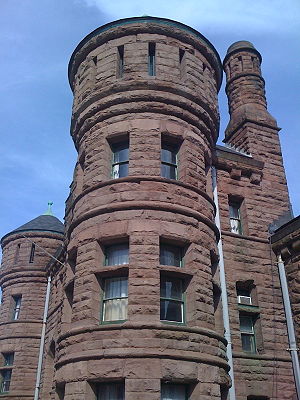
Halifax Armoury
Encyclopedia


Nova Scotia
Nova Scotia is one of Canada's three Maritime provinces and is the most populous province in Atlantic Canada. The name of the province is Latin for "New Scotland," but "Nova Scotia" is the recognized, English-language name of the province. The provincial capital is Halifax. Nova Scotia is the...
. The armoury was designed in 1895 by Chief Dominion Architect Thomas Fuller
Thomas Fuller (architect)
Thomas Fuller was a Canadian architect.He was born in Bath, Somerset , where he trained as an architect. Living in Bath and London he did a number of projects. In 1845 he left for Antigua, where he spent two years working on a new cathedral before emigrating to Canada in 1857...
, and was opened the next year and work on the structure was completed in 1899. While the exterior is based on a medieval castle, it was actually one of the most advanced structures of its day. It was pioneering in its use of a series of Fink trusses to create a large interior space with no columns or walls, and is today the oldest surviving example of a such a building. It was also one of the first buildings in Halifax to be lit by electricity
Electricity
Electricity is a general term encompassing a variety of phenomena resulting from the presence and flow of electric charge. These include many easily recognizable phenomena, such as lightning, static electricity, and the flow of electrical current in an electrical wire...
.
The building remains an active military structure. It has played an important part in many Canadian wars, being an important transit point for soldiers before departing by ship for the Boer War
Second Boer War
The Second Boer War was fought from 11 October 1899 until 31 May 1902 between the British Empire and the Afrikaans-speaking Dutch settlers of two independent Boer republics, the South African Republic and the Orange Free State...
and both World War
World war
A world war is a war affecting the majority of the world's most powerful and populous nations. World wars span multiple countries on multiple continents, with battles fought in multiple theaters....
s. After the Halifax Explosion
Halifax Explosion
The Halifax Explosion occurred on Thursday, December 6, 1917, when the city of Halifax, Nova Scotia, Canada, was devastated by the huge detonation of the SS Mont-Blanc, a French cargo ship, fully loaded with wartime explosives, which accidentally collided with the Norwegian SS Imo in "The Narrows"...
the armoury provided shelter for many who had lost their homes.
The armory is currently the home base of 1st (Halifax-Dartmouth) Field Artillery Regiment
1st Field Artillery Regiment, Royal Canadian Artillery
The 1st Field Artillery Regiment, RCA, is a Canadian Forces reserve artillery regiment. It is located in Halifax, Nova Scotia, at the Halifax Armoury...
, The Princess Louise Fusiliers
The Princess Louise Fusiliers
The Princess Louise Fusiliers is a Primary Reserve infantry regiment of the Canadian Forces.-History:Based in Halifax, Nova Scotia, this infantry regiment traces its local roots as a Halifax unit of Militia back to June 18, 1798 when Sir Edward Cornwalis formed a local Militia under his own command...
, and several other reserve units.

